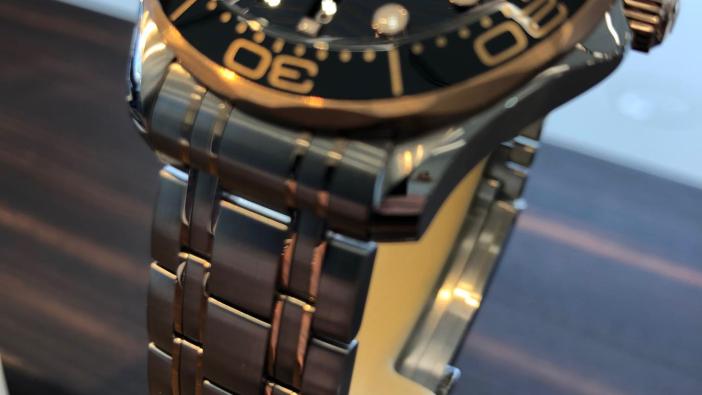
The building is an environmental friendly optimized for production, and constructed in concrete and wood.
The visit began with the automated central stock warehouse. The warehouse is built in the center of the factory for optimal operations. Totally automated with robots, only two employees operate the entire system and it runs 24/7. The operations continue after office hours with unmanned operations throughout the night. During this critical night ops, the robots reorganize and optimize the boxes. The space is provided for 30,000 boxes, with about 9% intentionally free to allow free movement for optimal operations.
To robotic arm is mounted on conveyer belt and capable of moving at 4m/s. The entire warehouse is in a sealed room where the oxygen levels is reduced to 15.2% to lower the risk of fire and corrosion.

Omega policy mandates no photography in the building. So we have no more photographs to share after this point.
The architecture is of the building is quite interesting. We were led into an aquarium like room three floors above the entrance. This room had glass walls on 3 sides. Through these glass walls, we can see rows upon rows of watchmakers working in their lab coats. Two additional glass openings allow a top down look into the central storage.

Each operator is enclosed in a laminar box with positive pressure so the environment is dust free. No paper is allowed as that might bring in dust, so the operators get their instructions and note their work by the use of iPads.
On this floor, the T2 operations are performed. This is where the hands are set on the dial and the movement is encased. About 140 operators work on the floor, a total of about 350 operators in the entire factory. This is hand worked production in an industrial scale. Making some 700,000 watches a year. Each Omega watch is touched by about 20 operators from start to finish.

Next floor up is the METAS certification by the Federal Institute of Meteology. The office is not owned by Omega, but operates independently within the Omega building. This is a government institute responsible for maintaining standards for Switzerland. They set standards like the length of 1m, the mass of 1kg. In this capacity, they work with Omega to set the standards of watch precision. In the office, the METAS staff are responsible for ensuring the standards are met. Random testing is carried out by these staff here.
On the same floor, but outside of the METAS room, all other testing are being carried out by Omega personnel. Here the tests are made to 100% of the watches. Among the tests, is the 15,000 Gauss magnetic field test is performed with the use of one of the two giant magnets here. As a reference, 15,000 Gauss is the field strength inside an MRI.
The same floor houses the laser engraving machines which put serial numbers and other markings.

T3 is also performed in the facility. This is located on the first floor. T3 is the final assembly step where the watch head is attached to the bracelet. This process is cheekily nicknamed “marriage”. Documentation tags like the Master Chronometer Certificate is also attached here and the final watch is put into a sealed plastic for shipping.
With that, we concluded the manufacture visit. We hope it gives a small glimpse into the Omega behemoth.
Regards,
Peter Chong
Live from Biel.





4 Comments
Why rush? You’re writing about a luxury brands operation, not a natural disaster. No ones going to die because you didn’t publish this ASAP.
Just seems sloppy and a poor reflection of the quality of this site. If I wanted a poorly written, rushed story I’ll just go on the forums.
We do two kinds of write ups. We started the Live from series in SIHH this year with the immediate, raw style and have gotten excellent reception. Servers crashed the first day of SIHH because of the extraordinary demand, and we already have a rather large server farm (1TB data served on normal months). And luckily we recovered within an hour as our service provider worked hard to do that.
So there are many who like this on-the-fly style. If you prefer considered articles, we have those too, and appreciate that you read those.
As I see it, more choices is a good thing.
Nice article about the operations at Omega, but did anybody bother to proofread this? There are many many grammatical and syntactical errors throughout. A 6th grade teacher would hand it back to the student for a re-write.
The article was not proof read. And written on the fly as we walked through the manufacture. And was published as we completed the visit. Apologies for the errors but we wanted to get this out as fast as possible.